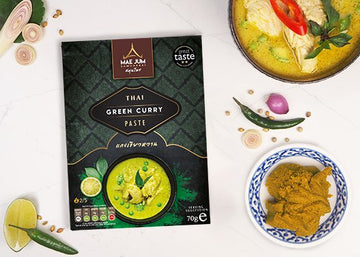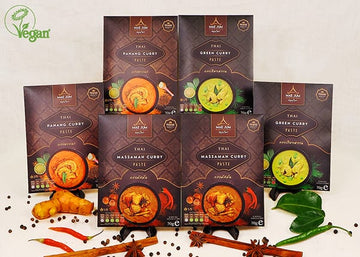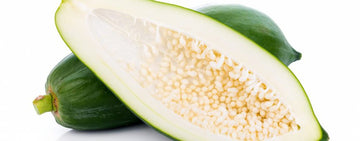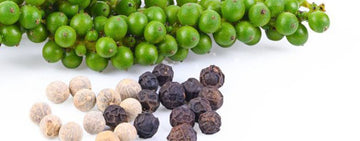Everything You Need to Know About Green Papaya: A Key Ingredient in Thai Cuisine
Welcome to Mae Jum's blog, where today we’ll be exploring the versatile and nutritious green papaya. Often overlooked in Western kitchens, green papaya is a key ingredient in Thai cuisine and offers a variety of culinary and health benefits. Though you may be more familiar with its sweet, orange counterpart, green papaya is simply the unripe version of the same fruit. Despite its unfamiliarity to many, it holds a special place in Thai dishes, particularly in savoury salads like Som Tam.
This blog will guide you through everything you need to know about green papaya, including its origins, how to prepare it, where to buy it, and its health benefits.
What is Green Papaya?
Green papaya, known for its firm, pale green flesh, is the unripe form of the tropical fruit Carica papaya. This fruit grows on papaya trees, which can reach heights of up to 12 feet. While ripe papaya is known for its vibrant orange-red flesh and sweet flavour, green papaya is harvested earlier when the flesh is firm, crunchy, and neutral in taste. Typically weighing between 650g and 1kg, the green papaya is pear-shaped, with smooth green skin and a hollow core filled with white seeds, which eventually turn black as the fruit ripens.
Though technically a fruit, green papaya is used more like a vegetable in cooking due to its lack of sweetness and crisp texture. In Thailand, it is the star of Som Tam (green papaya salad), a dish that showcases the perfect balance of Thai flavours—sweet, sour, salty, and spicy.

How to Prepare and Cook with Green Papaya
Though its appearance might seem intimidating at first, green papaya is easy to prepare once you know the steps. First, start by peeling the outer skin with a vegetable peeler. Unlike other tough-skinned fruits, the skin of green papaya is relatively soft, making this task simple. As you peel, you may notice a white latex-like liquid seeping from the skin—this is the papaya’s natural latex, which can easily be wiped away.
Next, cut the papaya in half and scoop out the white seeds with a spoon. While the flesh is the primary part used in dishes, the seeds can also be consumed. They have a peppery flavour and can be dried and ground to use as a spice, similar to black pepper.
Once the seeds are removed, you can shred the flesh of the papaya using a julienne peeler or a cheese grater. If you want to try the traditional Thai method, hold the peeled papaya in one hand and use a sharp knife to make a series of long, thin cuts into the flesh. Then, slice off the top layer into a bowl, repeating the process until the entire papaya is shredded. The result is fine, crunchy strands of green papaya that serve as the perfect base for a salad or stir-fry.
Cooking with Green Papaya
Green papaya's neutral flavour makes it an ideal carrier for bold dressings and seasonings. In Som Tam, the shredded papaya absorbs the punchy flavours of the dressing, which typically includes palm sugar for sweetness, fish sauce for saltiness, lime juice for acidity, and chillies for heat. The resulting salad is a perfect balance of these four essential Thai flavours, with the crisp texture of the papaya providing a refreshing contrast to the spicy and tangy dressing.
Green papaya can also be used in soups, stews, and stir-fries, where it retains its crunch and absorbs the flavours of the other ingredients. Its versatility means that it can be used in a variety of savoury dishes, much like a vegetable.
Where to Buy and Store Green Papaya
In the UK, green papaya can be difficult to find in mainstream supermarkets, but it is commonly available at Asian grocery stores. Larger stores with a good selection of fresh produce are more likely to stock green papayas, especially those catering to Thai and Southeast Asian communities. The price typically ranges from £5 to £7 per fruit, or £9 to £10 per kilogram.
When selecting green papaya, look for one with a smooth, vibrant green skin. The fruit should feel firm to the touch, without any soft spots or blotches, which could indicate over-ripeness or poor storage. If the skin has begun to turn yellow, it’s a sign that the papaya is starting to ripen, and while it may still be edible, it won’t have the crisp texture ideal for dishes like Som Tam.
Once you’ve brought your green papaya home, store it in a plastic bag in the fridge. If you plan on keeping it for more than a few days, wrapping it in a paper towel can help absorb excess moisture, prolonging its freshness.
If you’re unable to find green papaya, green mango makes a suitable substitute. Like green papaya, green mango is the unripe version of the fruit and has a similarly firm, crunchy texture and tart flavour. For a more readily available alternative, cucumber or swede can be used in certain recipes, though they won’t replicate the exact texture and flavour of green papaya.

Health Benefits of Green Papaya
Green papaya isn’t just a versatile ingredient in the kitchen—it’s also a powerhouse of nutrition. Packed with vitamins and minerals, this fruit offers numerous health benefits, making it a great addition to a balanced diet.
1. Rich in Vitamins and Antioxidants
Green papaya is an excellent source of vitamins, particularly vitamin C, vitamin A, vitamin E, and folate. These vitamins are essential for maintaining a healthy immune system, promoting skin health, and supporting overall well-being. The high concentration of antioxidants found in green papaya helps to neutralise free radicals, reducing the risk of chronic diseases and slowing down the ageing process.
2. Improves Digestion
Green papaya is known for its high fibre content, which can aid digestion and promote gut health. The fibre helps regulate bowel movements, reduce bloating, and improve nutrient absorption. Additionally, the fruit contains papain, an enzyme that breaks down proteins and makes digestion easier. This is why green papaya is often used as a natural meat tenderiser in cooking.
3. Supports Skin Health
Thanks to its rich vitamin C and E content, green papaya can be beneficial for the skin. These vitamins help to boost collagen production, which is essential for maintaining skin elasticity and preventing wrinkles. The antioxidants in green papaya also work to protect the skin from damage caused by free radicals, helping to reduce the appearance of age spots, blemishes, and other signs of ageing.
4. Boosts Immunity
Green papaya is an excellent source of vitamin C, with just one serving providing more than 70% of your daily requirement. Vitamin C is crucial for boosting the immune system, as it helps stimulate the production of white blood cells, which are essential for fighting off infections. Regular consumption of green papaya can help strengthen your immune system and keep you feeling healthy.
5. Promotes Heart Health
The nutrients in green papaya, including potassium, magnesium, and fibre, contribute to cardiovascular health by helping to regulate blood pressure and reduce cholesterol levels. The high fibre content can also prevent the build-up of cholesterol in the arteries, reducing the risk of heart disease.

Conclusion: Green Papaya in Thai Cuisine and Beyond
Green papaya may not be as well-known in the UK as its ripe counterpart, but it plays a vital role in Thai cuisine, particularly in dishes like Som Tam. Its firm, crunchy texture and neutral flavour make it the perfect carrier for bold dressings and seasonings, while its impressive nutrient profile offers a range of health benefits.
Whether you’re an experienced home cook or new to Thai cuisine, green papaya is a fantastic ingredient to experiment with. It’s versatile, nutritious, and adds a unique texture to any dish. While it may take a bit of searching to find green papaya in UK stores, it’s well worth the effort for those looking to recreate authentic Thai flavours at home.
So next time you’re in an Asian grocery store, why not pick up a green papaya and try your hand at making Som Tam or another Thai dish? You’ll not only enjoy a delicious meal but also reap the numerous health benefits that this remarkable fruit has to offer.
If you enjoyed reading our ‘get to know: green papaya’ blog post, please give this blog a star rating and comment if you have cooked with this ingredient before or would like to give it a go in the near future! Check out our blog for more interesting articles like this and subscribe for new recipes and posts. Always stay connected and follow us on Instagram and Facebook!








Hi Winsome, cooking green papaya is similar to cooking butternut squash about 10-20 minutes if boiled depending on the size of the cut.
How long do you have to cook the green pawpaw?